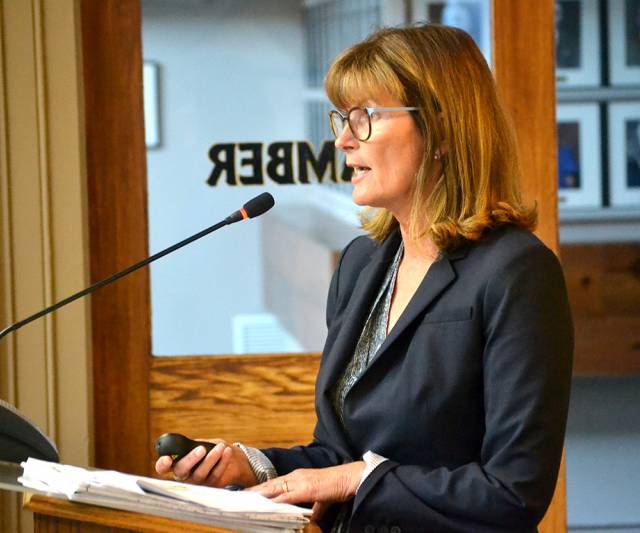
Lisa Helps, Mayor of Victoria, B.C., speaks to the United Nations on Sept. 21, 2019 about nature-based solutions in urban areas. Photo by Fatima Syed
Could a governor of Papua New Guinea and the mayor of Victoria save the oldest, largest tropical forests in the southwestern Pacific from climate change?
It sounds unlikely but that’s the very serious conversation Victoria Mayor Lisa Helps found herself having on Sept. 21, at a dinner in New York with a Papua New Guinea governor and Nelson, B.C.’s Councillor Rik Logtenberg.
If the forest collapses in the climate crisis, the people of Papua New Guinea will not be able to survive, the governor told Helps, before making a direct plea for the help of western cities like Victoria and Nelson.
The dinner occurred hours after Helps pledged Victoria as the first Canadian city to participate in the United Nations Trees in Cities Initiative, which challenged mayors of cities around the world to boost their urban forests as a means to lower carbon pollution.
Standing with the mayors of Triana, Albania; Bonn, Germany; and Helsingbord, Sweden, Helps vowed to plant 5,000 trees.
It’s not a very ambitious goal, Helps admitted in an interview with National Observer in New York. “But the actual footprint of the city of Victoria is tiny — it’s just 20 square kilometers. So 5,000 is a good start,” she said. “My hope is that our residents will rally and will be able to plant 10,000 trees in one year.”
“Ten years ago, we didn’t think cities had the capacity and the ability to solve climate change. This is, I think, a new thing.” – Victoria Mayor @lisahelps
Helps doesn’t know how the city of Victoria and its more than 85,000 residents caught the attention of the United Nations.
But her pledge illustrated the marked shift at the United Nations Climate Summit this year that saw climate leadership represented mostly at the local and sub-national level. Cities, towns and regions around the world took the stage to discuss nature-based solutions and local climate financing efforts, while their federal and national counterparts came later for the UN General Assembly.
According to UN Habitat, cities consume 78 per cent of the world’s energy and produce more than 60 per cent of greenhouse gas emissions. By 2050, cities will be home to two-thirds of the world’s population.
So, while Canada’s federal leaders took to the election campaign trail at home, mayors such as Helps, Valérie Plante of Montreal, Berry Vrbanovic of Kitchener, Ont. and Naheed Nenshi of Calgary took to the UN to listen, learn and promote best sustainable practices and nature-based solutions in cities.
Provincial environment ministers from British Columbia and Quebec were also present at the summit to boost their carbon-pricing plans — one of the four key focuses of the United Nations this year.
“One of the key shifts is that cities are now seen as key actors,” Helps said in an interview. “Ten years ago, we didn’t think cities had the capacity and the ability to solve climate change, This is, I think, a new thing. And it’s hopefully not only going to shift the dialogue at the summit, but also shift the kinds of actions that happen coming out of it.”
Honoured to present at the UN Climate Summit on a panel Local Leadership for Climate: Solutions to the Climate Emergency. #mayorsbinder #yyj #climateactionsummit
‘A reality check’
Helps was only invited a week before the Sept. 21 Climate Summit in a letter that touted the City of Victoria’s efforts in improving the management of trees on public and private lands through an annual $1-million investment in an Urban Forest Master Plan.
In 2019, the City of Victoria allocated nearly $3 million to maintain and enhance the city’s urban forest.
“I believe there is a lot we can learn from the progress your city has already achieved in this area, and I would like to help you share this achievement with other cities and allow them to learn from it,” Under-Secretary-General Olga Algayerova wrote in the invitation. MORE







